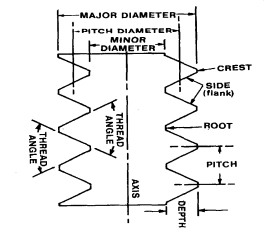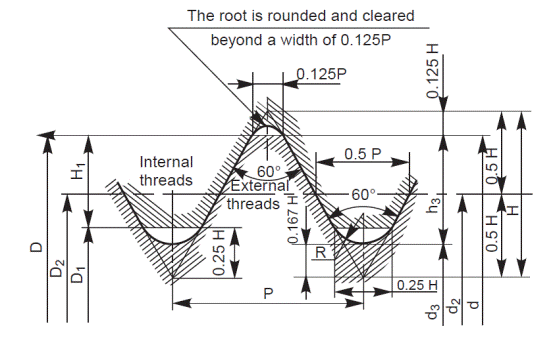Esta calculadora de par de apriete esta basad en la norma UNE 17-108-81. En ella para calcular el par de apriete se indica el uso de las siguientes expresiones:
$$M_T=\frac{F_T}{1000}\left[0,161P+0,583\mu{d_2}+0,25\mu(D_e+D_i)\right]$$
Donde
- $P$ es el paso de la rosca en milimetros;obtenido de la norma ISO 965-part 2
- $\mu$ es el coeficiente de rozamiento entre la cabeza del tornillo y el apoyo (que se ha considerado similar al coeficiente de rozamientos de la rosca)
- $d_2$ diametro medio de la rosca del tornillo expresado en mm; obtenida de la norma ISO 965-part 2
- $D_e$ Diametro maximo de la superficie de rozamiento de la cabeza del tornillo, que seria equivalente al valor de $d_w$ para cada una de las cabezas de los tornillos. En este caso el valor se ha extraido de cada una de las normas que definen las cabezas de los tornillos (DIN 7623,DIN 7643,DIN 7991,DIN 908,DIN 912,DIN 931,DIN 933,DIN 934,DIN 960,DIN 961,ISO 10642,ISO 4014,ISO 4017,ISO 4032,ISO 4762,ISO 8676,ISO 8765,MBN 10105)
- $D_i$ Diametro minimo de la superficie de rozamiento de la cabeza del tornillo, que seria equivalente al valor de $d_a$ para cada una de las cabezas de los tornillos. En este caso el valor se ha extraido de cada una de las normas que definen las cabezas de los tornillos (DIN 7623,DIN 7643,DIN 7991,DIN 908,DIN 912,DIN 931,DIN 933,DIN 934,DIN 960,DIN 961,ISO 10642,ISO 4014,ISO 4017,ISO 4032,ISO 4762,ISO 8676,ISO 8765,MBN 10105)
- $F_T$ es la carga a traccion del tornillo debida al par de aprite que viene definida por la siguiente expresion
$$F_T=\frac{0,8EA_S}{\sqrt{1+3\left[\frac{4}{1+\frac{d_3}{d_2}}\left(\frac{P}{\pi{d_2}}+1,155\mu\right)\right]^2}}$$
Donde
- $E$ es limite elastico en $N/mm^2$ y se ha obtenido del valor $R_{p0,2}$ de la norma ISO 898-1 (ISO) para cada una de las clases de calidad
- $A_S$ es la seccion resistente en $mm^2$ se han obtenido de la norma ISO 965-part 2 en funcion de la metrica de la rosca para metrica (ISO)
- $d_2$ diametro medio de la rosca del tornillo expresado en mm; obtenida de la norma ISO 965-part 2
- $d_3$ diametro del nucleo de la rosca del tornillo expresado en mm; obtenida de la norma ISO 965-part 2
$Nota1:$En el caso que se desconozca la norma que define la cabeza del tornillo el programa asigna a los valores de $D_e$ y $D_i$, unos valores medios de todos los tipos de cabeza. Esto no afecta significativamente al resultado
$Nota2:$En el caso de desconocer las superficies de contacto el valor predeterminado por el programa para el coeficiente de rozamiento ($\mu$) es 0,1
Another function is to help to check the maintainability. If you introduce the screw standard and thread size you will have the link to the recommended 3D models tools in order to check the required space to apply torque and to remove the screw. This will help to check that the design is easy to mantain and prevent future redesign process during the assembly. You only have to insert the tool in your 3D model and you will see that the bolt head clearance for the wrench, spanner or socket is enough.



